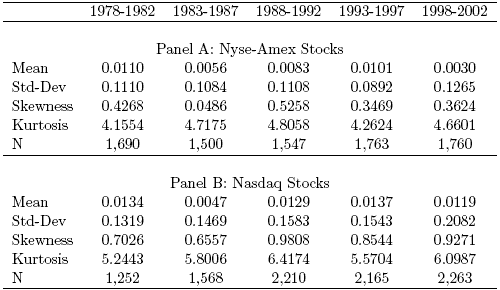Are factor models universal, or does each group of related stocks have a unique set of factors for predicting differences in future returns? In their September 2007 paper entitled “How Common Are Common Return Factors Across NYSE/AMEX and Nasdaq?”, Amit Goyal, Christophe Perignon and Christophe Villa propose a general procedure to identify pervasive risk factors and apply the methodology to identify similarities and differences between the return structures of the specialist-controlled NYSE/AMEX and the computer-driven Nasdaq. Using monthly return data for large samples of NYSE/AMEX and Nasdaq stocks over the period 1978-2002 (25 years), divided into five 60-month subperiods, they find that:
- While there are three important pervasive factors for both NYSE and Nasdaq stocks, no more than two are common to both groups. In other words, there is a substantial difference between the return structures of stocks on the two exchanges.
- There are at most three pervasive factors for both groups across a long time horizon, suggesting that two-factor or three-factor models are adequate to describe the cross-section of stock returns for any given group of stocks.
- With respect to widely used factors:
- The market factor (beta), the principal factor of factor models, typically has the highest correlation with the above common pervasive factors. However, the importance of the market factor in explaining variation of returns among stocks has decreased over time.
- The importance of the size effect seems to have decreased over time.
- The importance of the value premium has increased over time (although not monotonically).
- The addition of a momentum factor only marginally improves the explanatory power of the other widely used factors.
The following table, taken from the paper, summarizes top-level differences in excess (relative to the one-month Treasury bill yield) monthly return statistics for stocks traded on the NYSE/AMEX and Nasdaq over five 60-month subperiods during 1978-2002. NYSE/AMEX has more stocks (N) in early subperiods, while Nasdaq has more in later subperiods. Nasdaq stocks tend to be more volatile than NYSE/AMEX stocks, and this difference has increased over time. Nasdaq stocks also have higher skewness and kurtosis than NYSE/AMEX stocks. These differences support the conclusion from general factor analysis that there are significant differences between the cross-sectional structures of NYSE/AMEX and Nasdaq returns.

In summary, while dominant factors may be common, different groups of stocks require different factor models to explain the variation in returns among individual stocks within them.